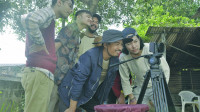Entertainment
The artists of siff
The dimly lit auditorium changed its glow—from a soft blue shade to pink, orange and red.
Shaleen Shah
The dimly lit auditorium changed its glow—from a soft blue shade to pink, orange and red. The big screen stood patiently in front of its growing audience who were crowing in by the second into the room. The urgent chitter-chatter of the organisers was a constant hum with the music playing in the ambient background. Suddenly, the big screen lit up and all was silent. Collectively, the audience sat back and directed their gaze towards the screen.
“The movies are only sixty seconds long. I’ll probably never watch more movies in one sitting ever again,” I heard an eager attendee comment at the 60 Seconds International Film Festival(SIFF) which was held on the cloudy day of May 20 at Cine-De Chef, CTC Mall, Sundhara by Open Space Nepal (OSN) in collaboration with 60 Seconds International Film Festival (60th SIFF). The screening took place in partnership with Morango Films, a filmmaking company from Pakistan, the initiator of the festival that started in the year 2013.
Generally, the Nepali audience’s interest in documentaries can be patchy at best; they readily categorise documentaries as long, boring and tedious to watch. However, with the advent of SIFF, documentaries may stir up newfound interest and vigour among Nepali audiences. The event, which screened 35 different movies, was described as a display of robust “citizen journalism” by Muhammad Saif, the country director for the event. The short documentaries portrayed displays of personal, social, and global issues such as peace, interfaith, water, creative, fiction, comedy, environment, democracy, innovation, conflict, and tolerance.
A goldfish is seen, trapped, in a glass of water. A hand appears, holds the glass, and starts tilting it. Gasps of fear, surprise and angst is heard from the audience as water pours slowly, steadily out of the glass until none is left. The goldfish is doomed to a fate of slow death. The audience watches in horror as the hand puts the glass back into place. An air of grief and disbelief looms in the auditorium for a few seconds, and then the words “save water, save life” appears in bold letters on the screen.
This was one of the 35 different films which were screened at the event by global filmmakers, artists and animators from Nepal, Brazil, India, Spain, Pakistan, United States, and Afghanistan among many other countries. Out of them, 13 films were from Nepali filmmakers. Each film represented an artistic representation of a compelling and profound issue which was of genuine importance to the filmmakers.
The ever growing numbers of young minds who take flight from Nepal for better opportunities, the crippling scarcity of water despite Nepal supposedly being rich in water resources, the oversimplification of life as a collection of certificates, achievements, money, and status, the shameful, disheartening tags and generalisations society imposes on its members, the ever-growing dependence of Nepali youths on “momo and churot” as an irreplaceable and unavoidable commodity: these were some poignant issues which the Nepali films embodied and portrayed.
Sometimes, the most effective way to change people’s values and attitudes is by penetrating the vast network of ideas, experiences, memories and emotions and place therein an idea, a possibility, an awareness which roots itself in their mind and spreads: slowly, but surely. The individual which has mastery in this precious craft of inception is the artist, and the artists of SIFF who have contributed to the poignancy and sagacity of the 60 second movies have succeeded in portraying their ideas through creativity, spreading their ideas through art and beauty, leaving lasting impressions on their audience, and staying true to the nature of the artist.




 16.28°C Kathmandu
16.28°C Kathmandu










